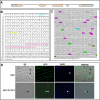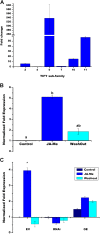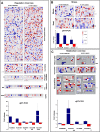Common bean (Phaseolus vulgaris L.) PvTIFY orchestrates global changes in transcript profile response to jasmonate and phosphorus deficiency
- PMID: 23402340
- PMCID: PMC3621168
- DOI: 10.1186/1471-2229-13-26
Common bean (Phaseolus vulgaris L.) PvTIFY orchestrates global changes in transcript profile response to jasmonate and phosphorus deficiency
Abstract
Background: TIFY is a large plant-specific transcription factor gene family. A subgroup of TIFY genes named JAZ (Jasmonate-ZIM domain) has been identified as repressors of jasmonate (JA)-regulated transcription in Arabidopsis and other plants. JA signaling is involved in many aspects of plant growth/development and in defense responses to biotic and abiotic stresses. Here, we identified the TIFY genes (designated PvTIFY) from the legume common bean (Phaseolus vulgaris) and functionally characterized PvTIFY10C as a transcriptional regulator.
Results: Nineteen genes from the PvTIFY gene family were identified through whole-genome sequence analysis. Most of these were induced upon methyl-JA elicitation. We selected PvTIFY10C as a representative JA-responsive PvTIFY gene for further functional analysis. Transcriptome analysis via microarray hybridization using the newly designed Bean Custom Array 90 K was performed on transgenic roots of composite plants with modulated (RNAi-silencing or over-expression) PvTIFY10C gene expression. Data were interpreted using Gene Ontology and MapMan adapted to common bean. Microarray differential gene expression data were validated by real-time qRT-PCR expression analysis. Comparative global gene expression analysis revealed opposite regulatory changes in processes such as RNA and protein regulation, stress responses and metabolism in PvTIFY10C silenced vs. over-expressing roots. These data point to transcript reprogramming (mainly repression) orchestrated by PvTIFY10C. In addition, we found that several PvTIFY genes, as well as genes from the JA biosynthetic pathway, responded to P-deficiency. Relevant P-responsive genes that participate in carbon metabolic pathways, cell wall synthesis, lipid metabolism, transport, DNA, RNA and protein regulation, and signaling were oppositely-regulated in control vs. PvTIFY10C-silenced roots of composite plants under P-stress. These data indicate that PvTIFY10C regulates, directly or indirectly, the expression of some P-responsive genes; this process could be mediated by JA-signaling.
Conclusion: Our work contributes to the functional characterization of PvTIFY transcriptional regulators in common bean, an agronomically important legume. Members from the large PvTIFY gene family are important global transcriptional regulators that could participate as repressors in the JA signaling pathway. In addition, we propose that the JA-signaling pathway involving PvTIFY genes might play a role in regulating the plant response/adaptation to P-starvation.
Figures







Similar articles
-
JASMONATE-ZIM DOMAIN proteins engage Polycomb chromatin modifiers to modulate Jasmonate signaling in Arabidopsis.Mol Plant. 2021 May 3;14(5):732-747. doi: 10.1016/j.molp.2021.03.001. Epub 2021 Mar 3. Mol Plant. 2021. PMID: 33676023
-
A pair of nuclear factor Y transcription factors act as positive regulators in jasmonate signaling and disease resistance in Arabidopsis.J Integr Plant Biol. 2024 Sep;66(9):2042-2057. doi: 10.1111/jipb.13732. Epub 2024 Jul 2. J Integr Plant Biol. 2024. PMID: 38953749
-
Plant hormone jasmonate prioritizes defense over growth by interfering with gibberellin signaling cascade.Proc Natl Acad Sci U S A. 2012 May 8;109(19):E1192-200. doi: 10.1073/pnas.1201616109. Epub 2012 Apr 23. Proc Natl Acad Sci U S A. 2012. PMID: 22529386 Free PMC article.
-
JASMONATE ZIM-DOMAIN Family Proteins: Important Nodes in Jasmonic Acid-Abscisic Acid Crosstalk for Regulating Plant Response to Drought.Curr Protein Pept Sci. 2021 Dec 29;22(11):759-766. doi: 10.2174/1389203722666211018114443. Curr Protein Pept Sci. 2021. PMID: 34666642 Review.
-
Jasmonates: biosynthesis, perception and signal transduction.Essays Biochem. 2020 Sep 23;64(3):501-512. doi: 10.1042/EBC20190085. Essays Biochem. 2020. PMID: 32602544 Review.
Cited by
-
The MicroRNA319d/TCP10 Node Regulates the Common Bean - Rhizobia Nitrogen-Fixing Symbiosis.Front Plant Sci. 2018 Aug 10;9:1175. doi: 10.3389/fpls.2018.01175. eCollection 2018. Front Plant Sci. 2018. PMID: 30147704 Free PMC article.
-
Gene Expression Responses to Sequential Nutrient Deficiency Stresses in Soybean.Int J Mol Sci. 2021 Jan 27;22(3):1252. doi: 10.3390/ijms22031252. Int J Mol Sci. 2021. PMID: 33513952 Free PMC article.
-
Genome-wide transcriptional changes triggered by water deficit on a drought-tolerant common bean cultivar.BMC Plant Biol. 2020 Nov 17;20(1):525. doi: 10.1186/s12870-020-02664-1. BMC Plant Biol. 2020. PMID: 33203368 Free PMC article.
-
Tissue-specific transcriptomic profiling of Plantago major provides insights for the involvement of vasculature in phosphate deficiency responses.Mol Genet Genomics. 2019 Feb;294(1):159-175. doi: 10.1007/s00438-018-1496-4. Epub 2018 Sep 28. Mol Genet Genomics. 2019. PMID: 30267144
-
The TIFY Gene Family in Wheat and its Progenitors: Genome-wide Identification, Evolution and Expression Analysis.Curr Genomics. 2019 Aug;20(5):371-388. doi: 10.2174/1389202920666191018114557. Curr Genomics. 2019. PMID: 32476994 Free PMC article.
References
-
- Broughton WJ, Hernández G, Blair M, Beebe S, Gepts P, Vanderleyden J. Beans (Phaseolus spp.) – model food legumes. Plant Soil. 2003;252:55–128.
-
- Phaseolus vulgaris v1.0. DOE-JGI and USDA-NIFA; http://www.phytozome.net/commonbean.
-
- Hernández G, Ramírez M, Valdés-López O, Tesfaye M, Graham MA, Czechowski T, Schlereth A, Wandrey M, Erban A, Cheung F, Wu HC, Lara M, Town CD, Kopka J, Udvardi MK, Vance CP. Phosphorus stress in common bean: root transcript and metabolic responses. Plant Physiol. 2007;144:752–767. doi: 10.1104/pp.107.096958. - DOI - PMC - PubMed
Publication types
MeSH terms
Substances
LinkOut - more resources
Full Text Sources
Other Literature Sources

